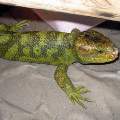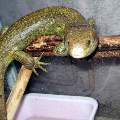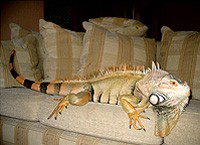
Monkey-tailed skink
When it comes to creatures that can perfectly move through trees, cling to them and hang for such a long time, monkeys come to mind for many of us, and certainly not lizards. In fact, not everyone knows that among reptiles there are capable of such tricks. To see this, just look at the chain-tailed skink (lat. Corucia zebrata), otherwise called monkey-tailed. This amazing lizard is the only reptile in the world that uses its tail to hang upside down from branches. She is the only representative of the monotypic genus of chain-tailed skinks and, in addition, a rather rare species, the export ban of which has been introduced by CITES.
Contents
Classification
Kingdom: Animals
Type: Chord
Class: Reptiles
Order: Scaly
Suborder: Lizards
Infraorder: Skinks
Family: Skink Genus:
Chain-tailed skinks
Species: Chain-tailed skink, monkey-tailed skink, zebra skink, giant skink.
Appearance
The monkey-tailed skink is indeed a large creature. Its dimensions reach 60-80 cm, half of which falls on a powerful tail that performs the function of the fifth limb. The weight of the lizard reaches half a kilogram and a little more. And the monkey-tailed skink is a real long-liver among reptiles, it can live up to 20 years. Initially, it was believed that there was a single species in the genus, but in the 90s of the 20th century two subspecies were discovered and described – the nominative Corucia zebrata zebrata and the northern Corucia zebrata alfredschmidti.
The color of the monkey-tailed skink varies from individual to individual. In general, it can range from olive to dark green with dark patches on the undersides of the paws. The ventral part of the body is noticeably lighter – a light green or cream shade with a mesh pattern. The small round eyes of the lizard can be bright yellow or dark brown. The body is quite powerful and elongated, the head is triangular in shape, the tail is also massive, and the limbs are short, but with long curved claws for greater tenacity, because the monkey-tailed skink is a tree reptile. Also, the lizard has small teeth on strong jaws, so the bite of the skink is quite sensitive. It is compared with a zebra for the fact that on the body there is a pattern of fuzzy transverse stripes. The differences between the two subspecies of monkey-tailed skinks are minor and appear mainly in eye colors. The typical nominative subspecies has white eye sclera, while the northern subspecies has black. The eyes themselves in Corucia zebrata zebrata are a combination of green and yellow, while in Corucia zebrata alfredschmidti their color can vary from several different shades of green to orange or almost black. And in general, the northern skink is more massive and with a shorter body, while the body of a typical skink is elongated, but it is lighter in weight.
With regard to sexual dimorphism, then, like many other reptiles, male monkey-tailed skinks are distinguished by their large size and wider head, as well as the presence of V-shaped scales in the tail near the cloaca.
Distribution and habitation
 The genus of monkey-tailed skinks is endemic to the Solomon Islands, an archipelago located in the Pacific Ocean off the northeast coast of Australia. Both subspecies settled on different islands of the archipelago. Corucia zebrata zebrata can be found on the islands of Choiseul, New Georgia, Santa Isabel, Guadalcanal, Malaita, San Cristobal, Santa Ana and Shortland. And the northern subspecies of Corucia zebrata alfredschmidti has taken root on the islands of Bougainville and Buka. Both subspecies prefer to live on mountain slopes overgrown with tropical rainforests, characterized by a huge variety of plants. And one of the skink’s favorite trees, where he often makes a home for himself, is Watkins ficus, the leaves of which the lizard, among other things, feed on.
The genus of monkey-tailed skinks is endemic to the Solomon Islands, an archipelago located in the Pacific Ocean off the northeast coast of Australia. Both subspecies settled on different islands of the archipelago. Corucia zebrata zebrata can be found on the islands of Choiseul, New Georgia, Santa Isabel, Guadalcanal, Malaita, San Cristobal, Santa Ana and Shortland. And the northern subspecies of Corucia zebrata alfredschmidti has taken root on the islands of Bougainville and Buka. Both subspecies prefer to live on mountain slopes overgrown with tropical rainforests, characterized by a huge variety of plants. And one of the skink’s favorite trees, where he often makes a home for himself, is Watkins ficus, the leaves of which the lizard, among other things, feed on.
The homeland of the monkey-tailed skink is limited exclusively to the Solomon Islands. The reptile is not found anywhere else, however, its number in nature has significantly decreased due to the once flourishing excessive export and hunting of local residents. But the monkey-tailed skink is a fairly ancient preserved species of tree lizards. It is the largest of the entire skink family. Due to its significant size and characteristic color, many different nicknames have been assigned to the lizard – a giant skink, a zebra skink, a monkey skink, etc. But the Latin generic name of the skink in its composition has the definition “Corucia” – “shimmering”, which indicates the iridescent effect produced by the scales of the reptile.
Behavior and lifestyle
 Most representatives of the fauna of the Solomon Islands are nocturnal or twilight. And the monkey-tailed skink is no exception. During the day, he hides in the dense canopy of trees, through which he moves very easily – for this, nature itself has adapted the skink’s body. With the help of the “fifth limb” – a strong tail – the skink is suspended from the branches upside down. And at dusk and at night, the lizard comes out to feed. In the morning, she prefers to bask in the sun – this form of behavior of the monkey-tailed skink is otherwise called basking and is associated with increasing and maintaining a suitable body temperature, which the lizard receives due to solar heat. Pregnant females can spend a whole hour in the sun. In the daytime, the reptile climbs into various shelters, for example, into tree hollows. With the help of strong claws, lizards perfectly climb not only trees, but also rocks.
Most representatives of the fauna of the Solomon Islands are nocturnal or twilight. And the monkey-tailed skink is no exception. During the day, he hides in the dense canopy of trees, through which he moves very easily – for this, nature itself has adapted the skink’s body. With the help of the “fifth limb” – a strong tail – the skink is suspended from the branches upside down. And at dusk and at night, the lizard comes out to feed. In the morning, she prefers to bask in the sun – this form of behavior of the monkey-tailed skink is otherwise called basking and is associated with increasing and maintaining a suitable body temperature, which the lizard receives due to solar heat. Pregnant females can spend a whole hour in the sun. In the daytime, the reptile climbs into various shelters, for example, into tree hollows. With the help of strong claws, lizards perfectly climb not only trees, but also rocks.
By nature, monkey-tailed skinks are quite aggressive creatures. They actively defend themselves against enemies by hissing, scratching and biting. They do not tolerate lizards and their relatives if they violate their territory. Even within skink family groups, violent clashes sometimes occur. But, oddly enough, the monkey-tailed skink can be tamed and made an obedient pet.
The reptile, like a nocturnal creature, has a well-developed sense of smell. With its help, monkey-tailed skinks recognize the approach of their relatives or other animals. These reptiles take air samples with the help of their tongue.
In terms of nutrition, lizards manifest themselves as rather voracious creatures. Therefore, it is recommended to “equip” the terrarium with artificial plants, as live skinks will very quickly eat or trample. These reptiles are not only thermophilic, but also moisture-loving. They often live near water and can dive into it. So a suitable water container is also necessary in the skink’s artificial dwelling.
Food
 The monkey-tailed skink is a typical vegetarian. Its main food is leaves, flowers, fruits and shoots of various plants. He is immune to plant poison, which is dangerous to other creatures. And only at a young age, lizards can diversify their diet with animal feed or eat the feces of adult lizards, which are useful for the digestive microflora in order to digest fiber normally. In a terrarium, Monkey Tail Skinks are recommended to be fed vegetables with dark green leaves, such as green mustard, turnip greens, collard greens, dandelion, carrot leaves, zucchini, broccoli, etc. These vegetables can form the forage base of the lizard’s diet. And for a change, various fruits are suitable (in that strength, and exotic ones – kiwi, apples, bananas, pears, peaches, papaya, grapes, mangoes, oranges, figs), berries (strawberries, blueberries), some other vegetables (beans, cabbage, tomatoes, sweet potatoes, spinach, celery) and plant parts (chicory, rice shoots, cherry and hibiscus flowers). A fruit diet can be successfully replaced with fruit mixtures for children. And in general, any vegetable or fruit food offered to the skink should be cleanly washed, free of stones and seeds, and crushed. Sometimes, but not more than once a month, skinks can be given boiled eggs – a source of protein, and vitamin-calcium supplements are also needed from time to time. Feeding of monkey-tailed skinks is best coordinated with their daily rhythms and carried out in the evening or at night. Newborn skinks in the first 2 days of life receive food from the placental sac.
The monkey-tailed skink is a typical vegetarian. Its main food is leaves, flowers, fruits and shoots of various plants. He is immune to plant poison, which is dangerous to other creatures. And only at a young age, lizards can diversify their diet with animal feed or eat the feces of adult lizards, which are useful for the digestive microflora in order to digest fiber normally. In a terrarium, Monkey Tail Skinks are recommended to be fed vegetables with dark green leaves, such as green mustard, turnip greens, collard greens, dandelion, carrot leaves, zucchini, broccoli, etc. These vegetables can form the forage base of the lizard’s diet. And for a change, various fruits are suitable (in that strength, and exotic ones – kiwi, apples, bananas, pears, peaches, papaya, grapes, mangoes, oranges, figs), berries (strawberries, blueberries), some other vegetables (beans, cabbage, tomatoes, sweet potatoes, spinach, celery) and plant parts (chicory, rice shoots, cherry and hibiscus flowers). A fruit diet can be successfully replaced with fruit mixtures for children. And in general, any vegetable or fruit food offered to the skink should be cleanly washed, free of stones and seeds, and crushed. Sometimes, but not more than once a month, skinks can be given boiled eggs – a source of protein, and vitamin-calcium supplements are also needed from time to time. Feeding of monkey-tailed skinks is best coordinated with their daily rhythms and carried out in the evening or at night. Newborn skinks in the first 2 days of life receive food from the placental sac.
Reproduction
 The reproduction of monkey-tailed skinks is unique. They, unlike other reptiles, have a tendency to create permanent families, consisting of one male and 1-2 females. The leader in them, of course, is the male. Zoologists observing the behavior of lizards during mating noticed that skinks descend from trees for this. The male rather aggressively courts the chosen one, biting her sides, and then wrapping her tail around her tail. Mating lizards can last quite a long time – 10-40 minutes.
The reproduction of monkey-tailed skinks is unique. They, unlike other reptiles, have a tendency to create permanent families, consisting of one male and 1-2 females. The leader in them, of course, is the male. Zoologists observing the behavior of lizards during mating noticed that skinks descend from trees for this. The male rather aggressively courts the chosen one, biting her sides, and then wrapping her tail around her tail. Mating lizards can last quite a long time – 10-40 minutes.
The chain-tailed skink is distinguished by a rather rare type of reproduction among lizards – live birth. This means that the exchange of nutrients between the female and the embryo occurs through the placenta. That is, care for offspring in skinks begins already inside the womb, but does not end when it is born.
The female gives birth to a single sufficiently large child, and only in rare cases can there be 2-3 individuals in the litter. A small skink appears after 7-9 months, weighs more than 100 grams and reaches about 30 cm in length, that is, almost a third of the size of the female itself. From six months to a year, the offspring remains close to their parents, and all this time the skink mother can carry her baby on her back, and the father carefully guards the family. It is interesting that all this time the female shows amazing selflessness in relation to the child. Employees of nurseries where monkey-tailed skinks bred noted that it was difficult for a female who had given birth to even put food on it – she attacks all living things so aggressively that she can approach a small skink. Even a male skink mother is capable of attacking. She protects her shelter, in fact, with her body, blocking the path to it. And if the baby accidentally moves away from the shelter, then the female pushes him back with her nose. Thus, only when the skink begins to show sufficient independence, he leaves his parents. But before this time, the mother will continue to actively care for him.
Skinks also have an extremely peculiar attitude towards young animals. There are cases when a family of monkey-tailed skinks adopted someone else’s cub. But with adults, the situation is different – strangers are always expelled. In general, manifestations of aggression are also possible within the family group, which is why when breeding skinks in artificial conditions, it is recommended to first accustom the male to the female so that they do not injure each other.
In general, the behavior of monkey-tailed skinks during the breeding season is characterized by many surprising features. And the main one is the care of the offspring and its protection, which is characteristic only of mammals.
Sources of
http://www.zooclub.ru
http://ru.wikipedia.org/
http://en.academic.ru/
http://myreptile.ru





